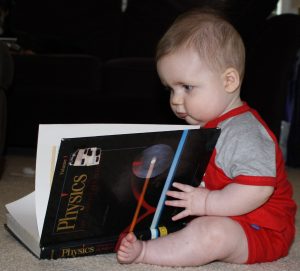When I was in school as a student and then a teacher I loved new textbooks. As a student it was great to be the first to put my name on the inside of the front cover. I also liked when the book was a couple of years old and I saw its previous users. That was the only thing I liked about getting a new textbook. As a student I never gave the learning process any thought -we read, memorized, took a test or skipped the reading- listened to a lecture – took a test. This became a very boring routine.
As I became well versed in the field of education, I realized that the textbook is only as good as the teacher who uses it. I understand now that the classes I hated were with the teachers that depended on the textbook for the only delivery of content.
 Today, most teachers realize that the textbook is just one tool – regardless of a virtual or a physical textbook. Occasionally teachers get lost in the overuse of the textbook and use it as the only source of information. More than enough, schools have textbooks older than 10 years, whereas the replacement cycle should be every seven years.
Today, most teachers realize that the textbook is just one tool – regardless of a virtual or a physical textbook. Occasionally teachers get lost in the overuse of the textbook and use it as the only source of information. More than enough, schools have textbooks older than 10 years, whereas the replacement cycle should be every seven years.
With today’s budgets, it is impossible to replace every core subject’s textbook using the seven-year cycle even if you replace one subject yearly. Typically, an elementary textbook cost more that $100 each helping textbook publishers to make a profit of more than $4 billion each year.
Physical textbooks quickly become damaged or lost and the content quickly becomes outdated.  If schools are attempting to overcome the physical textbook needs, and are turning to digital content, the major cost would be in purchasing and maintaining computers. The advantage being the digital content is continuously updated.
If schools are attempting to overcome the physical textbook needs, and are turning to digital content, the major cost would be in purchasing and maintaining computers. The advantage being the digital content is continuously updated.
For schools that cannot afford digital, the physical textbook is of paramount importance in a student’s education. As students are exposed only to a textbook the teacher converts its meaning and interpretation and imprints his or her own ideas on the minds of the students.
For the young student, textbooks influence gender roles and formulate stereotypes. Research shows a bias in gender stereotypes in occupational and domestic roles, with males being dominant in the occupational fields and females in the domestic roles. The study also indicates a male dominance in physical games with males in outdoor games and activities and females in less physical activities.
 Research reveals the questions in textbooks tend to be low level, meaning that they are written for immediate recall or memorization of facts and do not involve students in problem solving.
Research reveals the questions in textbooks tend to be low level, meaning that they are written for immediate recall or memorization of facts and do not involve students in problem solving.
With today’s differentiated classrooms, textbooks are written for a specified grade level that cannot be understood by all students; therefore, they do not inspire or motivate students to learn. How often do you go into a bookstore or log on to Amazon.com to order a textbook for enjoyment?
Teachers may be served well with the use of the textbook by supplying passages to be read and questions to ask students. The opposite happens with the student. It does not serve them well. Brain research states that the student learns better when they are actively involved. Actively involved does not mean turning pages or round-robin reading.
If your classroom only has textbooks available, make sure that it is only used as a tool and not as the curriculum. Textbooks are to be used sparingly and supplemented with other materials. Teachers and parents need to ask quality questions that inspire thought and complex thinking skills and not solely rely on the questions suggested in the textbook. Discover what students know about a topic prior to teaching and design the lesson based on prior knowledge and not the next chapter in the book. The most important thing to remember is that the textbook is only as good as the person using it, whether virtual or a physical book. Vast supports of outside resources are needed to support learning and make the learning enjoyable.



